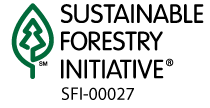xxx,xxx,xxx,xxx
METRIC TONS OF CO2
EQUIVALENT TO
SCRUBBING FROM THE AIR THE ANNUAL
CO2 EMISSIONS FROM xxx.xxx,xxx,xxx VEHICLES
Reviewing the THP
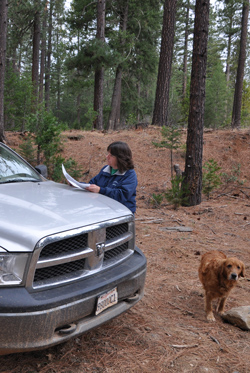
The forester carefully examines each Timber Harvesting Plan before undertaking any operations to make sure the activities prescribed in the plan are consistent with laws, regulations, and company policies.
Measuring Height
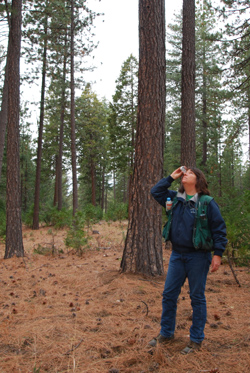
Foresters gather data about timber stands to calculate the volume of wood in the standing trees and the growth rate. Tree height measurements are a key element for those calculations. A clinometer is used as a sighting tool to establish the tree height.
Coring
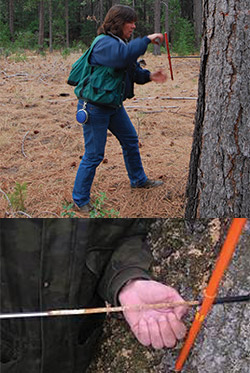
A number of trees are "cored" each year to determine the growth rate of a stand. Coring is done with an increment borer that shows the age of the tree by extracting a section of wood tissue. The science of tree aging is called dendrochronology.
DBH
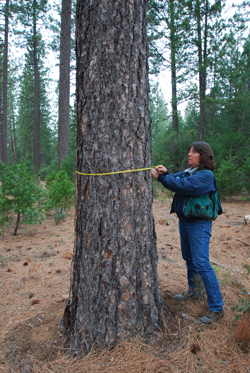
Diameter Breast Height (DBH) is a point 4.5 feet above the ground level where tree diameter is measured. This height avoids anomalies that can be caused by the swelling of the lowest section of the tree.
Flagging
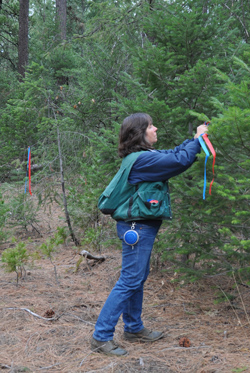
Foresters put ribbon or "flagging" at key locations in a timber stand to mark things such as roads, skid trails, and harvest unit boundaries.
Habitat Retention Area
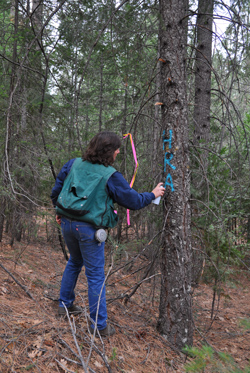
Timber management also includes practices which are designed to retain habitat for wildlife. These are areas within harvested units where clumps of trees are left which provide food and cover for a wide array of wildlife species.
Water Protection Zone
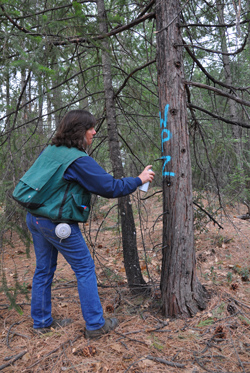
Each timber harvesting operation must comply with state standards for water quality protection. Water Protection Zones limit or prohibit logging and heavy equipment operation within a specified distance from the water course.
Marking Tree
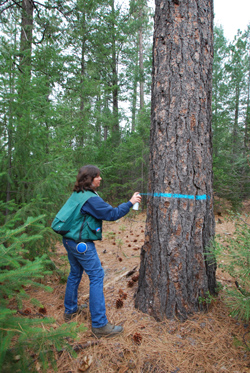
Foresters designate which trees in an area are to be cut (or left uncut) by painting the stem.
At Sierra Pacific, foresters and other natural resource professionals perform the following duties:
- Prepare forest and land management plans.
- Assess forest health.
- Develop management strategies for protecting the forest from insects, disease, and wildfire.
- Prepare silvicultural prescriptions, that provide wood for our sawmills, and protect water quality.
- Manage wildlife habitat, including the management and protection of listed species.
- Inventory and monitor forest resources.
- Measure standing timber volume and appraise its market value.
- Prepare Timber Harvesting Plans (THP). Under California law, a RPF must prepare a THP for review and approval by state agencies.
- Prepare plans to rehabilitate forests damaged by wildfire and other destructive natural forces.
- Provide information to forest landowners, the public and neighbors to increase their knowledge of forest ecology and management.
- Survey and protect archaeological resources.
- Assist in botanical, animal, and aquatic research.
- Prescribe the use of fire in forests.
- Administer logging, replanting, and thinning operations.
- Develop and Implement Long Term Sustained Yield plans.
- Collect seed and manage seed orchards to provide for replanting of all species harvested.
Sierra Pacific Industries has a team of over 200 specialists - foresters, wildlife biologists, botanists and more – that guide the sustainable management of our forests. From forest management to wildlife habitat to weather prediction to water quality monitoring. they are responsible for applying forestry principles and techniques to sustainably and responsibly manage forested landscapes.
Professional Foresters understand forest growth, development, and regeneration. Their education provides a broad background in archeology, soils, geology, hydrology, wildlife and fisheries biology, plant physiology, forest entomology, forest pathology, and other forest resources.
Foresters are also trained in fire management. Many have expertise in forest road design and timber harvest methods.
Wildlife Biologists work with foresters to ensure there is suitable habitat for the nearly 250 wildlife species which may be found on SPI’s forestlands. Suitable habitat includes areas for denning, nesting, canopy cover, rearing, and foraging which can be found in recently harvested areas with grasses and forbs or quiet stream sides which are home to fish, mammals, and raptors.
Trained professional biologists search for rare species and establish protection areas, perform surveys, cooperate with researchers at government agencies and universities to better understand species, and study how wildlife species live in managed forests. Biologists provide recommendations on how to best protect and enhance habitat for numerous species of wildlife.
Professional botanists are responsible for working with foresters during timber harvest planning. There are many plant species which only grow in specific geographic areas, on particular soils, or have a very narrow range. The goal of our botany staff is to find occurrences of these plants and provide protection measures before timber harvest begins. When habitat is present, we survey for flowering plants at the right time of year and notify our forestry staff. Over 2,300 sites with rare plants have been located on SPI lands that receive special attention from our botanists.

